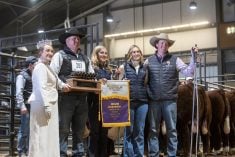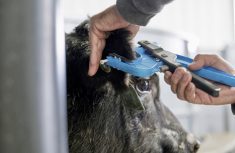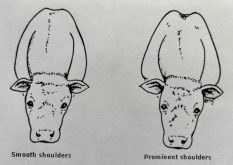Three Ontario beef farmers shared their thoughts around increasing performance and profitability through breeding choices. Their panel discussion was part of the 2020 Beef Symposium held at the University of Guelph earlier this year.
Brad Gilchrist
Beef marketing manager with Semex and owner, Gilchrist Farms, Lucknow, Ont.
Gilchrist Farms sell commercial and purebred breeding stock. Their predominantly Angus herd is focused heavily on elite genetics, artificial insemination and embryo transfer.
“Our culling criteria is around economics. If they don’t make sense for me, they won’t for customers, and I don’t want to replicate them in our program. We try to use every tool and we do genomic tests on all our cattle so that we know what we have genetically and phenotypically. We focus on breeding low birth (weight), high-performance cattle that will perform in a commercial setting and we use the show ring to showcase our genetics.”
Read Also

Body condition, nutrition and vaccination for brood cows
One of the remarkable events of the past century related to ranching has been the genetic evolution of brood cows….
Scott Cornish
Regional sales manager with Eastgen and beef farmer, Indian River, Ont.
Cornish and his wife have a Hereford and Angus herd. They both work off the farm and Cornish also exhibits and judges at leading beef shows in North America. He believes that using artificial insemination is important for genetic diversity; as well, show cattle being marketed need to be from recognizable pedigrees. They sell in two purebred sales and market stockers in the fall.
“The show ring is one of the few places the beef industry has to evaluate conformation and that’s important to our business. We record everything so it helps us see how we move our herd and we can see the impact specific bulls have on the herd average. We know our goals, have identified our profit drivers, and we ensure management practices push us to that. We also talk to semen reps who know the bulls and talk to customers who buy herd bulls to get different perspectives.”
Katie Wilson
Gilbrea Farm, Erin, Ont.
Wilson and her dad Bob raise Stabilizer seedstock as a co-operator herd with Leachman Cattle of Colorado. The Wilsons have been marketing bulls through Leachman Cattle Sales since 2008 and held their first annual sale on their own farm in 2015.
“You have to be able to identify your operational goals. Ours is selling quality breeding stock. Then it’s management practices and ensuring they align with those goals. Invest in the cows and know the bull. We need to know all their strengths and weaknesses, so we record everything, do DNA testing and do artificial insemination and natural service. We identify economically important traits and traits we want to improve on. I want every calf to be the best possible calf and play to a cow’s strength.”
With the new move towards forage-based programs, how does that affect you?
Gilchrist: Even though we are purebred producers, we’re producing for the commercial sector. Every index is created for a different purpose; when we talk about profitability, we need to select traits and index based on what you need to be successful. It’s evident to me that cattle on the grass-fed system are significantly different than those in a high-performance starch and grain environment, so you need different genetics for each. I would look at dry matter intake and residual average daily gain if I were breeding for a forage-based system. You need to look at those together.
Cornish: There are some things dairy is doing that we should have picked up on a long time ago. Beef needs to do a better job at finding efficient cattle and where they work. We are in Ontario, so we need to feed cattle corn, too. We need to address heel depth in cattle to address lameness. We’re constantly learning and need to find genetics that could go either way.
Wilson: Everyone needs to identify their own profit drivers that match their operation. Don’t fall into the trap of single trait selection; that’s not the right way to go.
How do you get more information from AI companies around making choices?
Gilchrist: Reach out to the AI company. At Semex, we are excited and proud to announce and declare to everybody that we do a lot of phenotypic analysis.
Cornish: Phone the semen companies and people who have used the bulls. Most purebred breeders strive for the next best ones. Sometimes we use new bulls that aren’t progeny-proven. We know that accuracy is important, but we’re also interested in raw ability and the bull doing what it says he will.
Wilson: Before a bull is released for use, he’s used heavily in co-operator herds. We build accuracy in new bulls that way. There is lots of data out there and animals to go and see to assess visually.
How many different sires do you use for your herd?
Gilchrist: I don’t have a number I need to use; it’s about understanding what we have in the cow. I get to see all the sires every AI company uses over the year, so I have a good understanding of the bull in that AI gun. I identify low birth-weight females, high-performance females and carcass traits and try to balance out EPDs (Expected Progeny Differences) with phenotypes. I also look at the foot quality on all the females we have.
Cornish: We have started to limit the number of bulls. I can get a better feel for a bull when I use just one or two across the herd.
Wilson: We use eight to 10 different AI sires. That’s what the cows matched up with.
How important is feed efficiency to you?
Gilchrist: It’s more than just one trait, it’s residual average daily gain and dry matter intake together. You don’t want cattle eating a lot but not converting it. But I look at performance first even though we get paid on the pounds they put on.
Cornish: We need more data. For sustainability this could be the number one trait we should look at, but I’m not sure we’re at that stage yet to leverage it. We can improve the industry and profit on-farm.
Wilson: It’s very important. It’s on my list of top traits to work on; we run feed efficiency tests on our bulls because we want efficient bulls that will convert well for customers.
What do the majority of customers ask for in a bull and do they value all the work you do in balance breeding or multiple traits?
Gilchrist: Our customers look at calving ease and performance, a stout, rugged bull with capacity. Flat-sided cattle that aren’t appealing get sorted.
Cornish: Women ask price first and always ask about birth weight. Men look at bulls first then ask the price. Know where you’re buying from and that you can trust that they can back up what they say.
Wilson: Calving ease and low birth weight are the first things customers ask for.
Originally from a dairy and beef farm in southern Ontario, Lilian Schaer is a freelance agricultural journalist and communications professional based near Guelph, Ont. You can follow her on Twitter @foodandfarming.
















